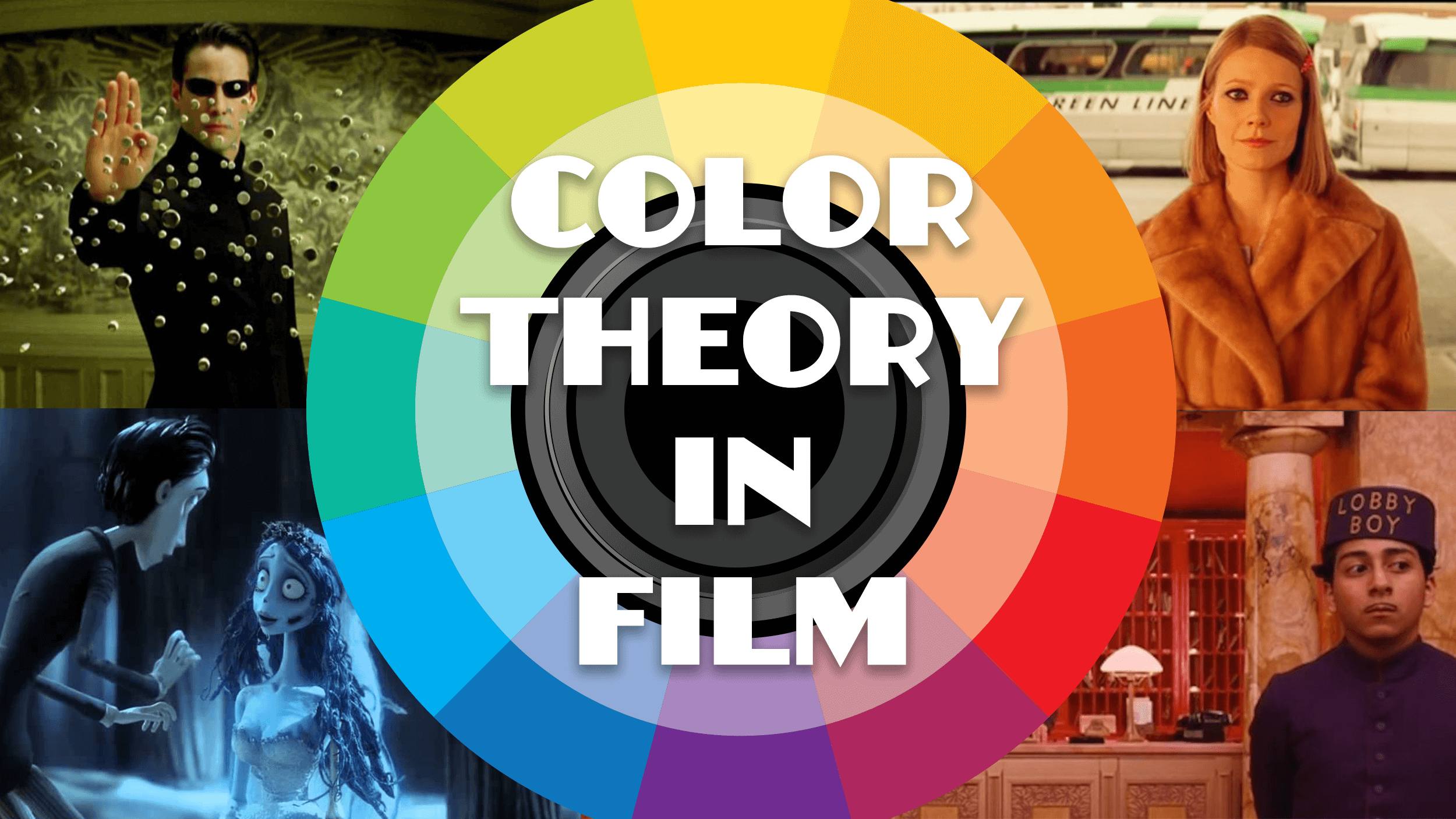
How can you make your film color palette part of the storytelling process?
Film color palettes might be one of the most underutilized parts of your filmmaking process. It can be the difference between immersing your audience in a world or boring them to tears.
We all remember the first time we saw The Wizard Of Oz. There's that magical moment where we go from the sepia-tone to full color. The world explodes off the screen, and for a moment, we understand Dorothy's amazement as she enters Oz. Here at No Film School, we're big believers in the power of color to help harness your storytelling capabilities.

Table of Contents
How a Film Color Palette Can Make You a Better Filmmaker [W/ Infographics]
Think about your favorite movies.
What ate their color schemes like, and what do those film color palettes add to the story?
Today we're going to talk about what the use of color can bring to your film, and study how film color palettes can help amplify your work. As Roger Deakins said: "It’s easier to make color look good, but harder to make it service the story." So this will be fun. And hard. And we'll all learn a lot.
Let's get started.
Film Color
So what is film color?
Well, film color can refer to your movie actually being shot in color instead of black and white, but today we're going to talk about colors used in film elicit emotions from the audience.
We're going to focus on Film Color Theory today.
Film Color Theory Definition
The definition of Film Color Theory is a theory that states that certain colors in film illicit certain emotions from the audience. Manipulation of these colors can be used to guide the audience toward the intent of the author, juxtaposed against one another to send a message, or subverted to create dramatic irony.
To properly utilize Film Color Theory, you first have to take a look at the color wheel in a film.
The Color Wheel In Film
A color wheel or color circle is an organization of color hues around a circle, which shows the relationships between primary colors, secondary colors, tertiary colors, and other color combinations.
The infographic below details all the different kinds of colors and color combinations in cinema. It's an important tool for any director to keep by their side. This can help them decide how their sets should look, which costumes will pop on camera, and how scenes should be lit.
Directors wield a lot of power when it comes to what appears on the screen. Collaboration with the art department, cinematographer, and costume design people is so important. Color is not just how you balance the camera, but also how people are dressed and how sets look on screen.
Think about all the magnificent work done by Wes Anderson. His movies are defined by their color palettes and what emotions are expressed through those images.
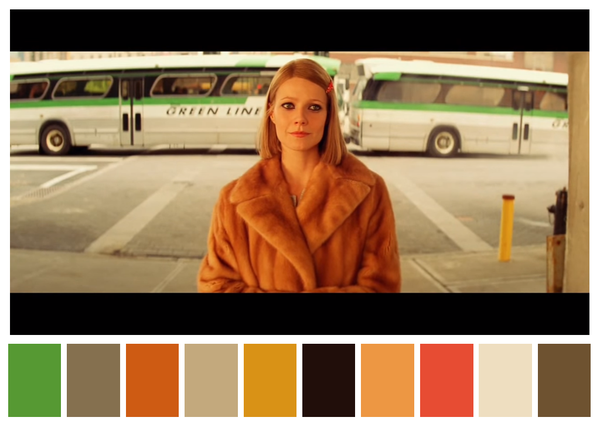
The colors expressed in this frame gives us the poppy world of this movie and set the dark and depressed tone of the film.
Anderson also can capture the opposite.
A world of adventure and a girl who wants to take on the world.

So let's break colors down.
What Goes Into a Color?
Hue
Hue is one of the main properties of a color, defined as "the degree to which a stimulus can be described as similar to or different from stimuli that are described as red, green, blue, and yellow." What it actually means is that hue refers to what color you're looking at. Or the color itself. 
Hue is great, but you need some other elements to deepen your color knowledge and express color on the screen.
Saturation
Saturation is another color property that describes how intense of a color we're getting. It's the deepness of the color at hand. The infographic below shows you how saturation works.

Value
The value of a color describes whether or not a color is dark or light. A dark blue would have a higher value. A light blue, a lower value.

Now that you understand how to choose and describe the colors you'll want in your movie color palette, let's check out how those colors can manipulate emotions on the screen and in the audience.
How Color Can Affect Emotions In Film
We all know that film is an empathy machine. A great story can take you pretty far, but film is a visual medium. We're not meant only to read things; we're meant to see things. And colors help us see the intentions behind what was on the page and what the director wants from us.
The below infographic sets up which colors will help you assign which emotions to scenes or parts of your movie or TV show.
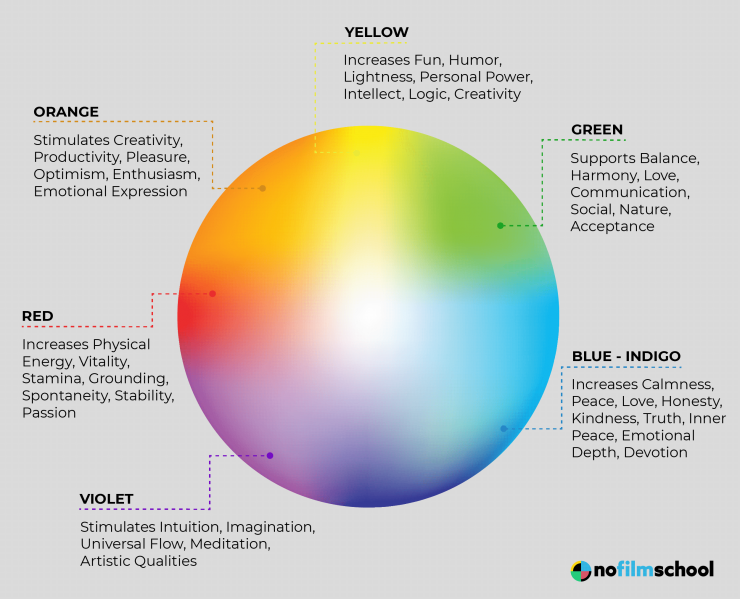
Here's a quick guide from one of our other posts on color:
- RED – anger, passion, rage, desire, excitement, energy, speed, strength, power, heat, love, aggression, danger, fire, blood, war, violence
- PINK – love, innocence, healthy, happy, content, romantic, charming, playfulness, soft, delicate, feminine
- YELLOW – wisdom, knowledge, relaxation, joy, happiness, optimism, idealism, imagination, hope, sunshine, summer, dishonesty, cowardice, betrayal, jealousy, covetousness, deceit, illness, hazard
- ORANGE – humor, energy, balance, warmth, enthusiasm, vibrant, expansive, flamboyant
- GREEN – healing, soothing, perseverance, tenacity, self-awareness, proud, unchanging nature, environment, healthy, good luck, renewal, youth, vigor, spring, generosity, fertility, jealousy, inexperience, envy
- BLUE – faith, spirituality, contentment, loyalty, fulfillment peace, tranquility, calm, stability, harmony, unity, trust, truth, confidence, conservatism, security, cleanliness, order, sky, water, cold, technology, depression
- PURPLE/VIOLET – erotic, royalty, nobility, spirituality, ceremony, mysterious, transformation, wisdom, enlightenment, cruelty, arrogance, mourning, power, sensitive, intimacy
- BROWN – materialistic, sensation, earth, home, outdoors, reliability, comfort, endurance, stability, simplicity
- BLACK – No, power, sexuality, sophistication, formality, elegance, wealth, mystery, fear, anonymity, unhappiness, depth, style, evil, sadness, remorse, anger
- WHITE – Yes, protection, love, reverence, purity, simplicity, cleanliness, peace, humility, precision, innocence, youth, birth, winter, snow, good, sterility, marriage (Western cultures), death (Eastern cultures), cold, clinical, sterile
- SILVER – riches, glamorous, distinguished, earthy, natural, sleek, elegant, high-tech
- GOLD – precious, riches, extravagance. warm, wealth, prosperity, grandeur
As you can see, many colors take on specific feelings. You need to support the color with actions and set pieces within the screenplay. You can't just add color blobs. You need to have artistic intention behind every frame. Take this image from Edward Scissorhands. Tim Burton is trying to set up an idyllic neighborhood to juxtapose against Edward's mansion. So he uses these pastel colors to make each house pop and to make the suburban lifestyle feel like a utopia.

Now that you understand how color is used, it's time to understand the "deeper why" of how it's used.
Time to grab your Freud book and to dig deep into Color Psychology in film.
Color Psychology in Film
What's Color Psychology in film?
This is the study of what complex emotions each hue can create when mixed with saturation and value. That's right, all our lessons are coming together! Let's take a look at this chart and really pull back the emotions and tone you can add to your stories.

First up, take a look at Harry Potter and the Deathly Hallows Part 2.
This is a somber movie. It's all about ending a series and the ending of many lives. That's not a joke. It's just a fact. So the movie thrives on the blues and greens, and not only of Lily's eyes. But you can't use bright blue and green. It has to be understated. That's where hue, saturation, and value come into play. It's muted, understated, and somber.
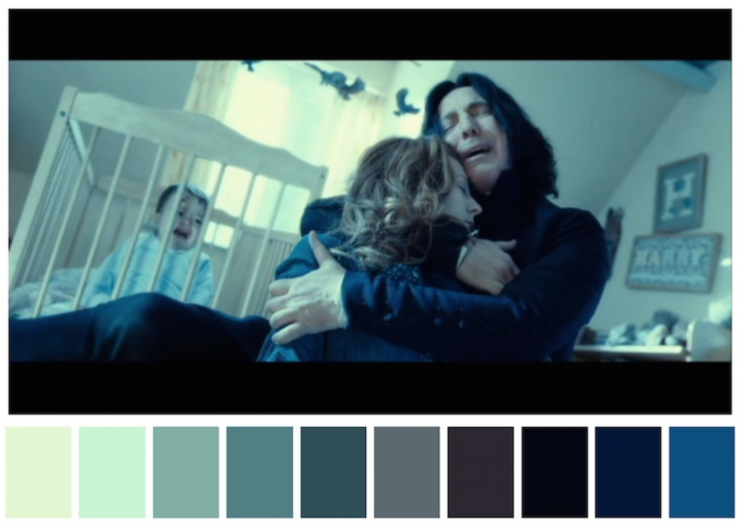
The Corpse Bride does exactly that by pushing more into primary color territory. It can be cold and somber, but these colors also give mystery and excitement.
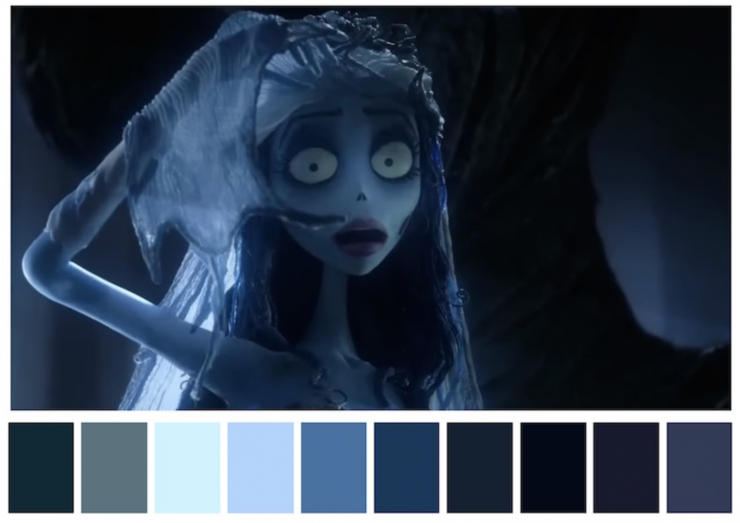
And sometimes you can also find stuff that's cold and warm. Like the movie Frozen.
Frozen combines the color schemes of the above two films, but pushes everything back into vibrant territory. It's a movie that plays off the cold of the snow but relates us to the warm characters searching for love and acceptance and family. 
These colors work well together. and there's a reason for that.
There are four main types of color schemes based on color concepts that work well together. Let's explore them.
Four Types Of Color Concepts
As you dig into color palettes in film, you're going to need to learn four color concepts that will help you choose what works in your film or TV show. Check out this other infographic that describes all of the four color concepts, and we'll break them down below.
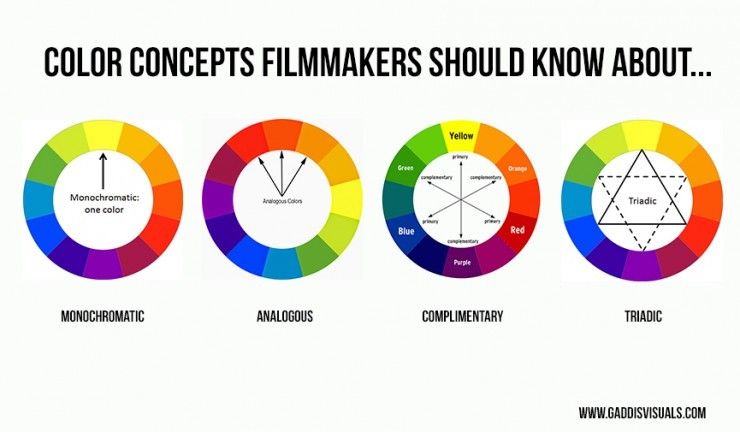
Monochromatic
Let's start with the most straightforward of the color concepts. Monochromatic color refers to a color scheme based around only one color. Like how The Matrix is based around the color green. It's in almost every frame, and becomes part of the movie.

Monochromatic doesn't have to be sad or somber. You can also have brighter monochromatic movies. Like how Grand Budapest Hotel thrives on different versions of pink with variations in saturation.

Analogous
An analogous color scheme in film or TV refers to colors that are neighbor on the color wheel. Filmmakers often choose from either warm or cool colors for their analogous schemes because they generally fit the theme of the movie or TV show. The idea here is to get colors that find balance or harmony together.
Check out this image from Moonlight. See how it's full of purples and blues?

The same goes for this image from Mary Poppins. All these colors work together and sit near one another on the wheel.

Again, this works with warmer tones, like this shot from Ang Lee's Life of Pi.

Complementary
Complementary colors are colors that are on the opposite ends of the color wheel but still look good together. You seem them used on screen a lot, but you also see them in movie posters a ton.


The idea behind these posters has to do with complementary colors that also play into our psychology. You can see how the manipulation of hue, saturation, and value plays into the tone of each of the movies represented in these posters.
You can try your hand at it with our movie poster template!
Outside of marketing, complementary colors also matter in storytelling. Like if you're trying to bring a couple together and to show their chemistry as well. And set them apart from the backdrop. 
Playing off these two complementary colors, we can add a third with the triadic color scheme.
Triadic
Triadic color schemes are schemes that use three colors from even distance on the color wheel. Like this poster for Inherent Vice.

That's poppy and neon, but what about something understated like the red doors in the Sixth Sense, juxtaposed against the yellow sand blacks in the rest of the movie?

Here we have impending doom and a highlighted thing for the audience to key in on as Bruce Willis's character moves toward the door.
But what about when filmmakers use colors that don't go together at all?
Discordant Movie Color Palettes In Film
Ahhh, it is true that opposites attract. Discordant colors are those that are almost opposite each other on a color wheel. In color theory, a complementary color is the one directly opposite of a color. That means yellow and purple are complementary colors because they are directly opposite each other. Which makes them discordant. Makes sense?
Yeah, it's confusing. But let's jump into some examples.

Often, directors use discordant colors to make something stand out. Like the girl in the red coat in Schindler's List.
Or the woman in the red dress in The Matrix.
It also thrives in movies like Pleasantville, which are all about colorizing a world that's decided it's okay to be mundane.

Associative Color Palettes In Film
The associative color palette in film or tv are basically the flag you fly when someone walks into a room. It's Umbridge's pink coat or Heisenberg's blue meth. It's the color we associate with the person or place.

Like the red of the entire rebel army in Star Wars. So we can also make the dirt under the salt red. Letting them fly their colors as they travel into battle.

Transitional Color Palettes in Film
You know I love a good character arc. If you're following my Free Screenwriting Seminar or Free Pilot Writing Seminar, you know that character arcs are incredibly important for dramatic conflict. You can mark these transitions with color to help emphasize them to the audience. Look how we used Walter White's transition into Heisenberg by darkening his attire and surroundings.

It doesn't have to be that drastic either.
One of my favorite recent films is Gone Girl. Look how Fincher uses the first and last scene of the movie.
In the beginning we see a cool toned woman, her innocence on display. The cool colors give us the feeling of death.
In the end, he's warmed it up, but now you know she's capable of anything. She's very much alive. and if you mess with her, you might wind up dead.

Look at all these different takes on Superman over the years. And how his colors were used to represent the tone of the movie and character.

Film Color Palette Generator
I scoured the internet and thought that the folks at Colormind have a pretty great color generator tool. Colormind is a color scheme generator that uses deep learning. It can learn color styles from photographs, movies, and popular art. You show them the colors you want, they pull them for you. It's very intuitive and sort of works like Shazam for colors.
I also like the work done by Movies In Color. They actually pull the colors and color spectrums from movies and make them accessible to people all over to understand how people achieve what's on screen.
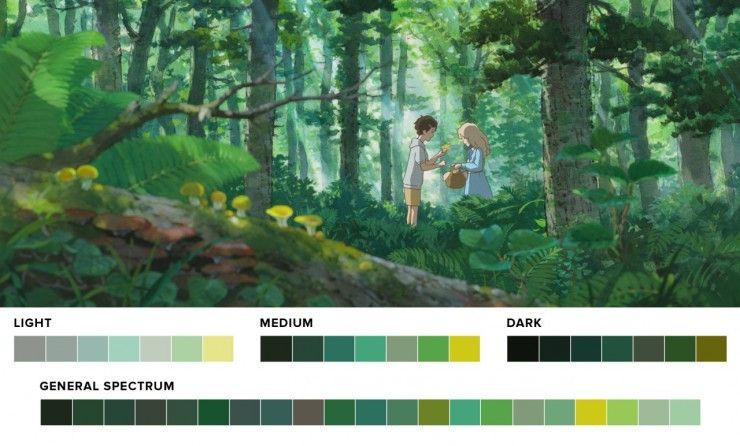
Summing up Color In Film
I hope this post has helped broaden your understanding of film color palettes and how they can be used to make your story pop off the screen. As you saw in our film color palette examples, having a great screenplay is a good start, but the story can only be intensified with excellent production design, editing, and color work.
So whether you want to learn about color grading, film colorists, or you're just obsessed with the way David Fincher uses color, you know you can find it all here.
Special thanks to the Twitter handle, @CinemaPalettes, where we got most of our images for this post.
What are some of your favorite uses of color in film?
Are there times color has taken you out of a story?
What are some great color tools for beginning and experienced filmmakers?
We want to hear your thoughts on making the colors in your movie color palette in the comments!
If you're interested in digging deeper on color, check out our post on how the colors of Wonder Woman help add dynamic action to the story!
Till next time...
Video is no longer available: www.youtube.com/watch?v=nX0DHd5QNS8
Your Comment
11 Comments
Those color palettes are so useless and..... LOL.
In my entire life, I have never seen any crew member running around with a color palette. In general, the DP judges how the light will be set up for a particular shot based on the directors wishes. No DP has a.... color pallette. It is a demand on their craft.
Those color palettes have no meaning because they are also inaccurate (just some samples of the entire picture).
I become exasperated with those young film students, doing only theoritcal shit.
February 20, 2019 at 11:14PM, Edited February 20, 11:14PM
Uhhhh these are basic color palettes that most DP's have memorized. If you don't know which colors compliment each other you really can't light a cohesive scene. Also the color palette is usually figured out before hand. The LUT the DIT and the DP use for dailies is usually based on the conversation around the color palette of the film. One morreeeeee thing, the DP makes a lot of the shot and color decisions. Yeah the director has a lot of input and final decision making, but the director hired a DP to help with those decisions. When ever we are working on a new feature at work 90% of the time the DP comes in for the grade, not the director.
October 22, 2019 at 11:21AM
I assume as a steadicam operator you are on set for one role and then no longer part of a project.
You do realise they are used extensively in pre production with heads of department to give you something to film, and then polished on set, and graded in post to accentuate, pull back or manipulate the colour palete decided upon in pre production
October 22, 2019 at 10:45PM
Jason, I think you've done a great job of pulling a load of colour-related ideas together. Thankyou.
One area where I struggle when colour correcting - e.g. using a colour balancing effect - is knowing what colour to add/emphasize to the current colour to achieve my desired colour. If I were mixing paint I could use one of the readily available colour wheels (cardboard rotating things which show you what you get if you add one colour to another). But I don't think this works for an RGB screen. Do you have any ideas on this - ever seen some kind of app which might help reduce the amount of trial and error I have to go through?
John
February 23, 2019 at 3:49AM
I would try this website / app
https://coolors.co/
February 26, 2019 at 8:16AM
Color Psichology is utter nonsense, not having any science backing it up. Of course there has been a historical use of color and we can hold on to that, but the psichologycal meanings of color are too dependant on personal experiences and cultural background to the point it is useless.
February 25, 2019 at 3:24AM
The other thing that is utter nonsense is your spelling of psychology.
There is plenty of science to back up an emotional response to colour. You just haven't looked, at all.
February 26, 2019 at 4:24AM
Wow.... sorry Juan but you just couldn't be more wrong. Maybe the subject matter is out of reach for you at this point.
October 22, 2019 at 5:26PM
Colour Theory in film is used to make decisions, sometimes you will go against the colour theory sometimes you will directly use it, sometimes you will create your own meaning through the events of the film for different palettes. But as a tool to tell to communicate the story colour theory and colour palettes are an invaluable tool for a director to communicate a idea or for department heads to interpret ideas.
Production designers and costume designers will always always alway develop a colour palette based on many many things but mostly how the director wants the audience to FEEL
October 22, 2019 at 10:43PM
Colour Psychology is a psuedo-science it's comparable to pre-formulated dream interpretations. You cannot assign meanings to colours which are textual abstractions not mathematical facts, its called the pathetic fallacy, in which humans attribute emotions to inanimate objects or things in the natural world (it was actually a form of art criticism developed by John Rushkin around Romanticist art). Doesn't mean we cannot evaluate colour and lighting as a poetic material just means you have to connect it to everything else and make a synthesis. I would say most of the craft regarding colour comes from intertextual research (other films, art works, specific cinematographic/photographic looks and effects) by the DIR/DOP/Poducer etc & investment/trust in the the COLOURIST who is actually doing this very nuanced job. Moreover there are just the limits of the technology that the film was made with that will be factors i.e. certain film stocks made in the 80s shot on old anamorphic lenses with certain lens coatings, with certain lights and paints from that era, telecined into oblivion, rediscovered re-scanned and re-coloured. see how deep the rabbit hole goes.
November 2, 2019 at 5:22PM, Edited November 2, 5:22PM
Nice summery.
It is important also to understand, that we do not see the same, that we may perceive colors differently from each other, and even differently in different emotional states, and thus perception of a given color is not static (we don't see it the same).
This point is also well presented by Beau Lotto (check out his TED talk).
There is a nice documentary on how we see colors by BBC: "Do you see what I see", which I strongly recommend.
To be useful all those palettes need to become LUTs. There is software, which can generate a LUT based on a color palette or even on a reference image (among other things). I don't think I can post links here (and diclaimer: I'm the developer), but you can find more information on reddit ( r/L_U_T/ )
December 23, 2019 at 4:06PM